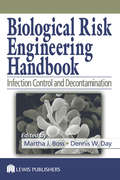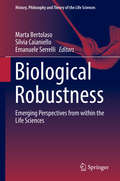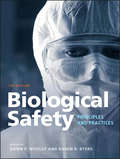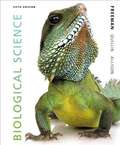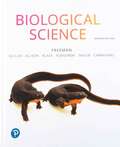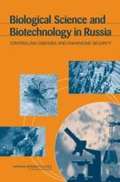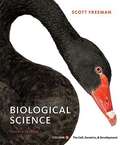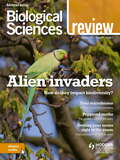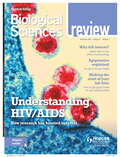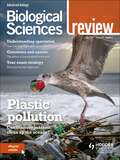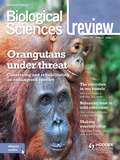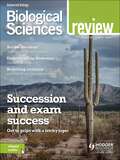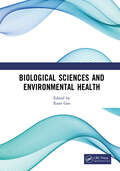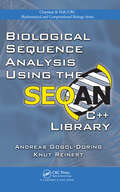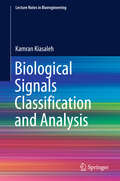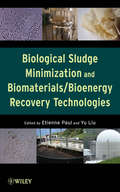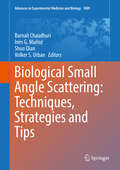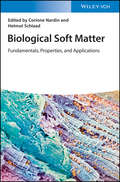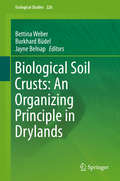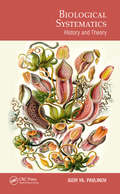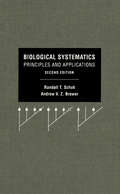- Table View
- List View
Biological Response Signatures: Indicator Patterns Using Aquatic Communities
by Thomas P. SimonThe use of environmental assessment procedures within monitoring frameworks demands that there be some relevancy to the decisions that management agencies make using biological criteria. These biological criteria standards are the basis for environmental indicators, which provide a direct measure of environmental quality. Biological Response Signat
Biological Risk Engineering Handbook: Infection Control and Decontamination (Industrial Hygiene Engineering)
by Martha J. Boss CSP Dennis W. DayThis handbook discusses biological risk engineering, an extension of industrial hygiene that involves the assessment, control, and decontamination of indoor biological risks. The book synergizes the knowledge of experts in various fields, from law to toxicology, to provide a compendium of information for applying science to limit biological risk.
Biological Robustness: Emerging Perspectives from within the Life Sciences (History, Philosophy and Theory of the Life Sciences #23)
by Marta Bertolaso Emanuele Serrelli Silvia CaianielloThis volume reviews examples and notions of robustness at several levels of biological organization. It tackles many philosophical and conceptual issues and casts an outlook on the future challenges of robustness studies in the context of a practice-oriented philosophy of science. The focus of discussion is on concrete case studies. These highlight the necessity of a level-dependent description of robust biological behaviors.Experts from the neurosciences, biochemistry, ecology, biology, and the history and the philosophy of life sciences provide a multiplex perspective on the topic. Contributions span from protein folding, to cell-level robustness, to organismal and developmental robustness, to sensorimotor systems, up to the robustness of ecological systems.Several chapters detail neurobiological case-studies. The brain, the poster child of plasticity in biology, offers multiple examples of robustness. Neurobiology explores the importance of temporal organization and multiscalarity in making this robustness-with-plasticity possible. The discussion also includes structures well beyond the brain, such as muscles and the complex feedback loops involved in the peculiar robustness of music perception. Overall, the volume grounds general reflections upon concrete case studies, opening to all the life sciences but also to non-biological and bio-inspired fields such as post-modern engineering. It will appeal to researchers, students, as well as non-expert readers.
Biological Safety: Principles and Practices (ASM Books #31)
by Dawn P. Wooley Karen B. ByersBiological safety and biosecurity protocols are essential to the reputation and responsibility of every scientific institution, whether research, academic, or production. Every risk—no matter how small—must be considered, assessed, and properly mitigated. If the science isn't safe, it isn't good. Now in its fifth edition, Biological safety: Principles and Practices remains the most comprehensive biosafety reference. Led by editors Karen Byers and Dawn Wooley, a team of expert contributors have outlined the technical nuts and bolts of biosafety and biosecurity within these pages. This book presents the guiding principles of laboratory safety, including: the identification, assessment, and control of the broad variety of risks encountered in the lab; the production facility; and, the classroom. Specifically, Biological Safety covers protection and control elements—from biosafety level cabinets and personal protection systems to strategies and decontamination methods administrative concerns in biorisk management, including regulations, guidelines, and compliance various aspects of risk assessment covering bacterial pathogens, viral agents, mycotic agents, protozoa and helminths, gene transfer vectors, zooonotic agents, allergens, toxins, and molecular agents as well as decontamination, aerobiology, occupational medicine, and training A resource for biosafety professionals, instructors, and those who work with pathogenic agents in any capacity, Biological safety is also a critical reference for laboratory managers, and those responsible for managing biohazards in a range of settings, including basic and agricultural research, clinical laboratories, the vivarium, field study, insectories, and greenhouses.
Biological Science
by Scott Freeman Michael Black Emily Taylor Kim Quillin Lizabeth Allison Greg Podgorski Jon MonroeBiological Science, Fifth Edition contains many new or expanded features, all of them targeted at ways to help students learn to construct their own knowledge and think like biologists. The book provides scaffolding to help students learn at the level called for by the National Academy of Sciences, the Howard Hughes Medical Institute, the American Association of Medical Academies, and the National Science Foundation.
Biological Science
by Scott Freeman Michael Black Emily Taylor Kim Quillin Lizabeth Allison Greg Podgorski Jeff CarmichaelFor introductory courses for biology majors. Discover biology, develop skills, and make connections Known for its discovery-based, student-centered approach, Scott Freeman’s Biological Science emphasizes higher-order thinking, enhances skill development, and promotes active learning. Biological Science equips students with strategies that go beyond memorization and guides them in making connections between core concepts and content, underscoring principles from the Vision and Change in Undergraduate Biology Education report. Students learn to apply their knowledge throughout the course, assess their level of understanding, and identify the types of cognitive skills that need improvement. The 7th Edition enables students to see that biology concepts are connected by weaving one case study throughout the entire text, helping students make connections across biology. New content includes updated coverage of advances in genomic editing, global climate change, and recent insights into the evolution of land plants. New embedded Pearson eText assets support content in the text with whiteboard Making Models videos, Figure Walkthrough videos, and BioFlix animations that engage students, help them learn, and guide them in completing assignments.
Biological Science (Fifth Edition)
by Scott Freeman Kim Quillin Lizabeth AllisonThis edition features the exact same content as the traditional text in a convenient, three-hole-punched, loose-leaf version. Books a la Carte also offer a great value for your students--this format costs 35% less than a new textbook. Supports and motivates you as you learn to think scientifically and use the skills of a biologist. Scott Freeman's Biological Science is beloved for its Socratic narrative style, its emphasis on experimental evidence, and its dedication to active learning. In the Fifth Edition, the author team has expanded to include new members --bringing a fresh focus on accuracy and currency, and multiplying the dedication to active learning by six. Research indicates that true mastery of content requires a move away from memorization towards active engagement with the material in a focused, personal way. Biological Science is the first introductory biology text designed to equip you with a strategy to accurately assess your level of understanding, predict your performance, and identify the types of cognitive skills that need improvement. Package Components: Books a la Carte for Biological Science, Fifth Edition
Biological Science and Biotechnology in Russia: CONTROLLING DISEASES AND ENHANCING SECURITY
by National Research Council of the National AcademiesIn July 2005, the National Academies released the report Biological Science and Biotechnology in Russia: Controlling Diseases and Enhancing Security. The report offered a number of recommendations that could help restore Russia’s ability to join with the United States and the broader international community in leading an expanded global effort to control infectious diseases. A proposed bilateral intergovernmental commission could play a pivotal role toward that end as cooperation moves from assistance to partnership. The report proposed the establishment of two model State Sanitary Epidemiological Surveillance Centers in Russia, more focused support of competitively selected Russian research groups as centers of excellence, the promotion of investments in biotechnology niches that are well suited for Russian companies, and expanded opportunities for young scientists to achieve scientific leadership positions in Russia. Also, the report highlighted the importance of U.S. programs that support the integration of former Soviet defense scientists with civilian researchers who had not been involved in military-related activities.
Biological Science, Volume 1: The Cell, Genetics, and Development (4th Edition)
by Scott FreemanBuilding upon Scott Freeman's unique narrative style that incorporates the Socratic approach and draws you into thinking like a biologist, the Fourth Edition has been carefully refined to motivate and support a broader range of learners as they are introduced to new concepts and encouraged to develop and practice new skills. Each page of the book is designed in the spirit of active learning and instructional reinforcement, equipping novice learners with tools that help them advance in the course-from recognizing essential information in highlighted sections to demonstrating and applying their understanding of concepts in practice exercises that gradually build in difficulty.
Biological Sciences Review Magazine Volume 31, 2018/19 Issue 1
by Philip Allan MagazinesThis A-level magazine makes cutting-edge biology research accessible and relevant for students, supporting them to get their best grade. Featuring the latest thinking on advanced topics, Biological Sciences Review aims to challenge students and increase their confidence with data, technical terms, practical experiments and exam skills.ContentsYour microbiome: what it is and why it matters Elle Lindsay The Atlantic ghost crab Martin Rowland and Geremis Luces Vital statistics Distributions and descriptive statistics Robert Spooner Upgrade New terms for a new term Martin Rowland Melanism and morphs: the genetics behind the peppered moth story Tom Parry Saffron Peter Gould and Liz Sheffield Using insects to protect crops: biological control of aphids Lucy Alford Spotlight The life cycle of a honeybee queen Leo Gamberini Prospects Becoming a patent attorney Dean Houston Could rabies be eliminated? How to eradicate a disease Sarah Cleaveland Impact Alien invaders: a tale of two crayfish Zara Gladman Images of biology Bee-eaters in aerial combat Rob Beynon and Jane Hurst
Biological Sciences Review Magazine Volume 31, 2018/19 Issue 2
by Philip Allan MagazinesThis A-level magazine makes cutting-edge biology research accessible and relevant for students, supporting them to get their best grade. Featuring the latest thinking on advanced topics, Biological Sciences Review aims to challenge students and increase their confidence with data, technical terms, practical experiments and exam skills. ContentsHIV: knowledge is power Michael McKenna Bioethics Inside the killing jar: why entomologists kill insects Adam Hart Making a muscle Teresa Audesirk Antibody protein structure Martin Rowland The genome remixed: epigenetics and human disease Paul Shiels, Laura Monaghan and Ognian Neytchev Banana blight Liz Sheffield and Kevin O'Dell Spotlight The curious biology of the naked mole-rat Chris Faulkes Upgrade Testing practical skills Martin Rowland Congenital heart disease Donna Page Prospects Technical paths into a world of research Lisa Jameson What is...? Immunology Phoebe Sharp Images of biology Collagen connections Marion Leibl
Biological Sciences Review Magazine Volume 31, 2018/19 Issue 4
by Philip Allan MagazinesThis A-level magazine makes cutting-edge biology research accessible and relevant for students, supporting them to get their best grade. Featuring the latest thinking on advanced topics, Biological Sciences Review aims to challenge students and increase their confidence with data, technical terms, practical experiments and exam skills.ContentsMarine bacteria and the plastisphereRobyn WrightBioethicsTackling cancer: getting personalChris WilmottSnake venomMax Drakeley, Liz Sheffield and Catherine McCrohanThe measure of a monkey: speciation and hybridsDuncan WrightProspectsFeeding the futureJoseph MoughanWhat is...?Sympatric speciationRobert Spooner and Raksha GohelProtecting the pinosaurLiz SheffieldLampreysCatherine McCrohanWhat is...?A ring speciesRobert Spooner and Raksha GohelStillbirthStacey Lee and Megan SharpsOutside the boxMaking sense of bird bristlesWater: transport and regulation in the bodyKevin MoffatUpgradeExams? You need a strategyMartin Rowland
Biological Sciences Review Magazine Volume 32, 2019/20 Issue 1
by Hodder Education MagazinesContents:The microbes thriving in our bowelsHidaya AlioucheSpotlightSaving the red apeKatie FrimstonBioethicsGenome editing: promises and problemsJohn BryantFighting fluSaira Hussain'Controlled variable' and 'control group'Martin RowlandCultivating clonesLiz SheffieldInterfaceModelling wildlife corridors: a tool for creating habitat in fragmented landscapesLydia ColeUpgradeWill examiners penalise my poor English?Martin RowlandUncoupling mitochondria turns up the heatKatrine WallisEvaluating experimentsThe Miller-Urey experimentAdam HartThe placentaKirsty McIntyreImages of biologyEvolution in your gardenKevin O'Dell
Biological Sciences Review Magazine Volume 32, 2019/20 Issue 2
by Hodder Education MagazinesAllergy explosion: why our immune systems react to harmless substancesCiara GartshoreBioethicsPractical ethics and prenatal screeningRebecca BennettUpgradeSuccess with successionMartin RowlandSpeciation and the tube mosquitoRobert SpoonerCollagen and scurvy: understanding the connectionEliana LingardBird adaptations for runningKevin MoffatTau protein: microtubule supporter or dementia driver?James QuinnOutside the boxThe future of food? Growing plants without soilJens ThomasSpotlightCoelacanth: how a lucky catch rewrote biologyAdam HartOur immune system: how it is controlled by stem cellsRachel OldershawProspectsWinning friends, influencing politicians: how can biologists influence those inpower?Rachel Lambert-ForsythImages of biologyMicrogreens on Mars?Liz Sheffield
Biological Sciences and Environmental Health: International Conference on Frontiers of Biological Sciences and Environmental Health (FBSEH 2023), November 3-5, 2023, Singapore
by Xuan GaoThe book captures the essence of the First International Conference on Frontiers of Biological Sciences and Environmental Health (FBSEH 2023). It provides a comprehensive roadmap to achieving sovereignty, security and safety of human health by adopting a multi-disciplinary approach to disease diagnosis, mitigation and prevention.These proceedings contains a repository of unique ideas, cutting edge research methodologies and exhaustive studies by experts, scholars from all over the world. It touches upon a wide array of topics including advances in bioengineering and genetic technologies, nutrition and disease prevention, emerging therapeutic strategies and drug delivery, along with the advent of microfluidics, wearables, and medical devices. It highlights innovative research contributions and practical applications that would prove critical in fighting cancer and genetic disorders in the future. This is a highly beneficial guide to university professors, research scholars and medical professionals in the rapidly evolving fields such as microbiology, biotechnology, biomedical engineering, molecular medicine, public health and community medicine, and healthcare sciences.
Biological Sciences in the Laboratory
by Ronald MollickWelcome to the Biology laboratory! This laboratory course is designed to meet one of the requirements of the Liberal Learning Core Curriculum. One of the Liberal Learning Areas of Inquiry is "Investigating the Natural World." This Area of Inquiry requires students to successfully complete two lecture classes and one laboratory class. The laboratory class must be related to one of the lecture classes taken. To use Biology 109L to help complete this requirement you must be currently enrolled in or have already completed one of the following: Biology 107, 108, 111, 112, 113, 114 or 115.
Biological Sequence Analysis Using the SeqAn C++ Library (Chapman & Hall/CRC Computational Biology Series)
by Andreas Gogol-Döring Knut ReinertAn Easy-to-Use Research Tool for Algorithm Testing and DevelopmentBefore the SeqAn project, there was clearly a lack of available implementations in sequence analysis, even for standard tasks. Implementations of needed algorithmic components were either unavailable or hard to access in third-party monolithic software products. Addressing these conc
Biological Signals Classification and Analysis (Lecture Notes in Bioengineering)
by Kamran KiasalehThis authored monograph presents key aspects of signal processing analysis in the biomedical arena. Unlike wireless communication systems, biological entities produce signals with underlying nonlinear, chaotic nature that elude classification using the standard signal processing techniques, which have been developed over the past several decades for dealing primarily with standard communication systems. This book separates what is random from that which appears to be random and yet is truly deterministic with random appearance. At its core, this work gives the reader a perspective on biomedical signals and the means to classify and process such signals. In particular, a review of random processes along with means to assess the behavior of random signals is also provided. The book also includes a general discussion of biological signals in order to demonstrate the inefficacy of the well-known techniques to correctly extract meaningful information from such signals. Finally, a thorough discussion of recently proposed signal processing tools and methods for addressing biological signals is included. The target audience primarily comprises researchers and expert practitioners but the book may also be beneficial for graduate students.
Biological Sludge Minimization and Biomaterials/Bioenergy Recovery Technologies
by Etienne Paul Yu LiuA comprehensive guide to sludge management, reuse, and disposal When wastewater is treated, reducing organic material to carbon dioxide, water, and bacterial cells-the cells are disposed of, producing a semisolid and nutrient-rich byproduct called sludge. The expansion in global population and industrial activity has turned the production of excess sludge into an international environmental challenge, with the ultimate disposal of excess sludge now one of the most expensive problems faced by wastewater facilities. Written by two leading environmental engineers, Biological Sludge Minimization and Biomaterials/Bioenergy Recovery Technologies offers a comprehensive look at cutting-edge techniques for reducing sludge production, converting sludge into a value-added material, recovering useful resources from sludge, and sludge incineration. Reflecting the impact of new stringent environmental legislation, this book offers a frank appraisal of how sludge can be realistically managed, covering key concerns and the latest tools: Fundamentals of biological processes for wastewater treatment, wastewater microbiology, and microbial metabolism, essential to understanding how sludge is produced Prediction of primary sludge and waste-activated sludge production, among the chief design and operational challenges of a wastewater treatment plant Technologies for sludge reduction, with a focus on reducing microbial growth yield as well as enhancing sludge disintegration The use of anerobic digestion of sewage sludge for biogas recovery, in terms of process fundamentals, design, and operation The use of the microbial fuel cell (MFC) system for the sustainable treatment of organic wastes and electrical energy recovery
Biological Small Angle Scattering: Techniques, Strategies and Tips (Advances in Experimental Medicine and Biology #1009)
by Barnali Chaudhuri Inés G. Muñoz Shuo Qian Volker S. UrbanThis book provides a clear, comprehensible and up-to-date description of how Small Angle Scattering (SAS) can help structural biology researchers. SAS is an efficient technique that offers structural information on how biological macromolecules behave in solution. SAS provides distinct and complementary data for integrative structural biology approaches in combination with other widely used probes, such as X-ray crystallography, Nuclear magnetic resonance, Mass spectrometry and Cryo-electron Microscopy. The development of brilliant synchrotron small-angle X-ray scattering (SAXS) beam lines has increased the number of researchers interested in solution scattering. SAS is especially useful for studying conformational changes in proteins, highly flexible proteins, and intrinsically disordered proteins. Small-angle neutron scattering (SANS) with neutron contrast variation is ideally suited for studying multi-component assemblies as well as membrane proteins that are stabilized in surfactant micelles or vesicles. SAS is also used for studying dynamic processes of protein fibrillation in amyloid diseases, and pharmaceutical drug delivery. The combination with size-exclusion chromatography further increases the range of SAS applications. The book is written by leading experts in solution SAS methodologies. The principles and theoretical background of various SAS techniques are included, along with practical aspects that range from sample preparation to data presentation for publication. Topics covered include techniques for improving data quality and analysis, as well as different scientific applications of SAS. With abundant illustrations and practical tips, we hope the clear explanations of the principles and the reviews on the latest progresses will serve as a guide through all aspects of biological solution SAS. The scope of this book is particularly relevant for structural biology researchers who are new to SAS. Advanced users of the technique will find it helpful for exploring the diversity of solution SAS methods and applications. Chapter 3 of this book is available open access under a CC BY 4. 0 license at link. springer. com.
Biological Soft Matter: Fundamentals, Properties, and Applications
by Corinne NardinExplore a comprehensive, one-stop reference on biological soft matter written and edited by leading voices in the field Biological Soft Matter: Fundamentals, Properties and Applications delivers a unique and indispensable compilation of up-to-date knowledge and material on biological soft matter. The book presents a thorough overview about biological soft matter, beginning with different substance classes, including proteins, nucleic acids, lipids, and polysaccharides. It goes on to describe a variety of superstructures and aggregated and how they are formed by self-assembly processes like protein folding or crystallization. The distinguished editors have included materials with a special emphasis on macromolecular assembly, including how it applies to lipid membranes, DNA condensation, and DNA fibrillization. Biological Soft Matter is a crucial resource for anyone working in the field, compiling information about all important substance classes and their respective roles in forming superstructures. The book is ideal for beginners and experts alike and makes the perfect guide for chemists, physicists, and life scientists with an interest in the area. Readers will also benefit from the inclusion of: An introduction to DNA nano-engineering and DNA-driven nanoparticle assembly Explorations of polysaccharides and glycoproteins, engineered biopolymers, and engineered hydrogels Discussions of macromolecular assemblies, including liquid membranes and small molecule inhibitors for amyloid aggregation A treatment of inorganic nanomaterials as promoters and inhibitors of amyloid fibril formation An examination of a wide variety of natural and artificial polymers Perfect for materials scientists, biochemists, polymer chemists, and protein chemists, Biological Soft Matter: Fundamentals, Properties and Applications will also earn a place in the libraries of biophysicists and physical chemists seeking a one-stop reference summarizing the rapidly evolving topic of biological soft matter.
Biological Soil Crusts: An Organizing Principle in Drylands (Ecological Studies #226)
by Burkhard Büdel Bettina Weber Jayne BelnapThis volume summarizes our currentunderstanding of biological soil crusts (biocrusts), which are omnipresent indryland regions. Since they cover the soil surface, they influence, or evencontrol, all surface exchange processes. Being one of the oldest terrestrialcommunities, biocrusts comprise a high diversity of cyanobacteria, algae,lichens and bryophytes together with uncounted bacteria, and fungi. The authorsshow that biocrusts are an integral part of dryland ecosystems, stabilizingsoils, influencing plant germination and growth, and playing a key role incarbon, nitrogen and water cycling. Initial attempts have been made to usebiocrusts as models in ecological theory. On the other hand, biocrusts are endangeredby local disruptions and global change, highlighting the need for enhancedrecovery methods. This book offers a comprehensive overview of the fascinatingfield of biocrust research, making it indispensable not only for scientists inthis area, but also for land managers, policy makers, and anyone interested inthe environment.
Biological Synthesis of Nanoparticles and Their Applications
by Shivendu Ranjan L. Karthik A. Vishnu Kirthi V. Mohana SrinivasanBiological Synthesis of Nanoparticles and Their Applications gives insight into the synthesis of nanoparticles utilizing the natural routes. It demonstrates various strategies for the synthesis of nanoparticles utilizing plants, microscopic organisms like bacteria, fungi, algae and so forth. It orchestrates interdisciplinary hypothesis, ideas, definitions, models and discoveries associated with complex cell of the prokaryotes and eukaryotes. Highlights: Discusses biological approach towards the nanoparticle synthesis Describes the role of nanotechnology in the field of medicine and its medical devices Covers application and usage of the chemicals at the molecular level to act as catalysts and binding products for both organic and inorganic Chemical Reactions Reviews application in physics such as solar cells, photovoltaics and other usage Microorganisms can aggregate and detoxify substantial metals because of different reductase enzymes, which can diminish metal salts to metal nanoparticles. The readers after going through this book will have detailed account of mechanism of bio-synthesis of nanoparticles.
Biological Systematics: History and Theory (Species and Systematics)
by Igor PavlinovThis volume reviews the historical roots and theoretical foundations of biological systematics in an approachable text. The author outlines the structure and main tasks of systematics. Conceptual history is characterized as a succession of scientific revolutions. The philosophical foundations of systematic research are briefly reviewed as well as the structure and content of taxonomic theories. Most important research programs in systematics are outlined. The book includes analysis of the principal problematic issues as "scientific puzzles" in systematics. This volume is intended for professional taxonomists, biologists of various specialties, students, as well as all those interested in the history and theory of biology and natural sciences.Key Features Considers the conceptual history of systematics as the framework of evolutionary epistemology Builds a hierarchically organized quasi-axiomatic system of taxonomic theory Contends that more reductionist taxonomic concepts are less objective Supports taxonomic pluralism by non-classic philosophy of science as a normal condition of systematics Documents that "taxonomic puzzles" result from conflict between monistic and pluralistic attitudes Related Titlesde Queiroz, K. et al., eds. Phylonyms: A Companion to the PhyloCode (ISBN 978-1-1383-3293-5)Sigwart, J. D. What Species Mean: A User's Guide to the Units of Biodiversity (ISBN 978-1-4987-9937-9)Rieppel, O. Phylogenetic Systematics: Haeckel to Hennig (ISBN 978-1-4987-5488-0)Wilkins, J. S. Species: The Evolution of the Idea, 2nd ed. (ISBN 978-1-1380-5574-2)
Biological Systematics: Principles and Applications
by Randall T. Schuh Andrew V. BrowerBiological Systematics: Principles and Applications draws equally from examples in botany and zoology to provide a modern account of cladistic principles and techniques. It is a core systematics textbook with a focus on parsimony-based approaches for students and biologists interested in systematics and comparative biology. Randall T. Schuh and Andrew V. Z. Brower cover: -the history and philosophy of systematics and nomenclature;-the mechanics and methods of analysis and evaluation of results;-the practical applications of results and wider relevance within biological classification, biogeography, adaptation and coevolution, biodiversity, and conservation; and-software applications.This new and thoroughly revised edition reflects the exponential growth in the use of DNA sequence data in systematics. New data techniques and a notable increase in the number of examples from molecular systematics will be of interest to students increasingly involved in molecular and genetic work.

